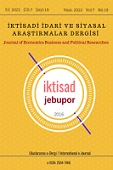MIST Ülkelerinde Satın Alma Gücü Paritesi Geçerli mi?
Is Purchasing Power Parity Valid in MIST Countries?
Author(s): Ferhat Karademir, Samet EvciSubject(s): Economy, Supranational / Global Economy, Economic policy, International relations/trade
Published by: Haci Mustafa Paksoy
Keywords: PPP; MIST; panel unit root; real exchange rate;
Summary/Abstract: Purchasing Power Parity (PPP) is one of the topics that has been studied with great interest in the economics and finance literature. PPP refers to the rate of change that equalizes the purchasing power of various currencies by eliminating the price level differences between countries. The validity of the PPP theory was tested by using various methods for various countries. In this study, it is aimed to examine whether the PPP hypothesis is valid in MIST (Mexico, Indonesia, South Korea, and Turkey) countries for the period 1994:01-2022:01. For this purpose, panel unit root tests are used to analyze whether real exchange rates are stationary or not. Due to the cross-sectional dependency between the units, the second generation unit root tests PANKPSS developed by Carrion-i-Silvestre et al. (2005) and CADF developed by Pesaran (2007) tests are used in the study, which takes cross-sectional dependency into account. While the findings obtained with the CADF test revealed that the series was not stationary and the PPP theory was not valid, the results of the PANKPSS test, which considered the structural breaks, concluded that the series was stationary, and the PPP theory was valid.
Journal: İktisadi İdari ve Siyasal Araştırmalar Dergisi (İKTİSAD)
- Issue Year: 7/2022
- Issue No: 19
- Page Range: 421-433
- Page Count: 13
- Language: Turkish

